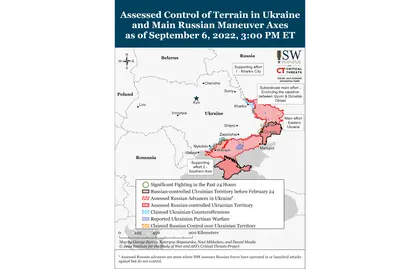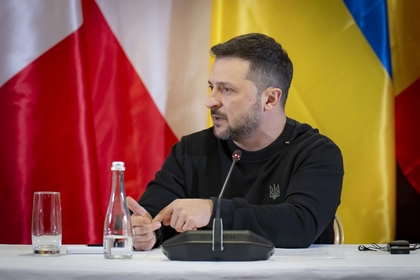Key Takeaways
- The International Atomic Energy Agency report released on September 6 describes Russian activities that increase the likelihood of a nuclear accident at the Zaporizhzhia Nuclear Power Plant while decreasing the ability of the plant’s personnel to respond to such an accident effectively.
- Ukrainian forces have launched likely opportunistic counterattacks in southern Kharkiv Oblast and retaken several settlements. Russian redeployments of forces from this area to defend against the Ukrainian counteroffensive in Kherson likely prompted and facilitated these counterattacks.
- Ukrainian forces are continuing an operational-level interdiction campaign and striking Russian logistics nodes, transportation assets, manpower and equipment concentrations, and control points across Kherson Oblast.
- Russian and Ukrainian sources discussed kinetic activity northwest of Kherson City and in western Kherson Oblast along the Inhulets River.
- Russian forces made incremental gains south of Bakhmut and continued ground attacks north, northwest, and southwest of Donetsk City.
- Russian authorities continue setting conditions to Russify Ukrainians living in Russian-occupied Ukrainian territory.
The International Atomic Energy Agency’s (IAEA) September 6 report on the situation at the Zaporizhzhia Nuclear Power Plant (ZNPP) described numerous ways in which Russian occupation authorities and the Russian military are jeopardizing the safe operation of the plant.[1] The report does not attempt to determine which party is responsible for the shelling that has damaged the facility and repeatedly calls on “all relevant parties” to take measures to improve the situation. The moderation and apparent neutrality of that language can overshadow the extremely clear articulation of the Russian activities undermining the plant’s safety and the fact that the report attributes no dangerous actions to Ukraine. The IAEA’s report is thus a coded condemnation of Russian moves that have created and are perpetuating the danger of nuclear disaster in Ukraine.
JOIN US ON TELEGRAM
Follow our coverage of the war on the @Kyivpost_official.
The report specifically notes that Ukraine reported to the IAEA that Russian forces had positioned military equipment in two turbine halls and various other facilities in and around the ZNPP.[2] It adds that the inspection team that finally visited the plant recently directly observed Russian military equipment in turbine halls and elsewhere around the plant.[3] It added that personnel from Russia’s state atomic energy organization, ROSATOM, were at the site and observed that “the presence of Rosatom senior technical staff could lead to interference with the normal lines of operational command or authority and create potential frictions when it comes to decision-making.”[4] It also noted that “the operating staff did not have unrestricted access to some areas, such as the spray cooling ponds, roofs of the buildings, and structures in the area of the water intake, and that access to the cooling ponds area was required to be granted by the military personnel at the site.”[5] The IAEA’s inspection team was told that “the on-site emergency centre was not accessible to the plant staff for emergency response as it was occupied by the military authority.” The team visited the alternative emergency center and observed that it lacked “an independent power supply or an independent ventilation system, and there is no internet connection to enable effective communication with all parties involved in an emergency response.”[6]

N. Korean Troops Massed in Russia to Enter Ukraine War ’Soon’: Pentagon Chief
The IAEA report thus demonstrates that Russian officials have placed military equipment in locations inhibiting access to essential facilities, installed their own personnel to oversee the plant’s operations in ways that the IAEA judges could undermine effective response to a nuclear emergency, restricted the Ukrainian operating staff’s access to key parts of the facility, and shifted the emergency center to a location lacking essential components vital to an effective response to a serious nuclear emergency. The Russians have thus created conditions at the ZNPP that increase the risk that an emergency could occur and significantly increase the danger that the operating staff will be unable to respond efficiently and effectively in such an event.
Russian President Vladimir Putin could seek to use the fears that his actions are causing to coerce the IAEA and the international community into a de facto recognition of Russia’s right to be involved in the operation of the ZNPP, which he might seek to portray as de facto recognition of Russia’s occupation of southern Ukraine. The somewhat coded language of the IAEA report reflects the fact that Ukraine remains the operator of the ZNPP and the party responsible for its safe operation and for complying with the IAEA under international law. The IAEA cannot directly engage Russia regarding the plant’s operation without at least tacitly admitting that Russia has some right to be consulted. Putin might seek to take advantage of this situation to attempt to create a process analogous to the Minsk Accords that established the “ceasefire” in Ukraine following Russia’s 2014 invasion. The Minsk and Minsk II agreements treated Russia as a neutral party rather than a participant, thereby tacitly accepting Putin’s assertion that Ukraine was in civil war rather than the victim of Russian aggression. Putin might seek to use the conditions he has created at the ZNPP to establish a parallel international framework undermining Ukraine’s sovereign rights over the much greater expanse of Ukrainian territory Russian forces now occupy.
Ukrainian forces conducted a counterattack in Kharkiv Oblast near Balakliya that likely drove Russian forces back to the left bank (north side) of the Severskyi Donets and Serednya Balakliika rivers on September 6. Ukrainian forces likely captured Verbivka (less than 3 km northwest of Balakliya) on September 6.[7] Geolocated footage posted on September 6 shows Ukrainian infantry in eastern Verbivka (less than 3 km from Balakliya).[8] Multiple Russian sources acknowledged Ukrainian gains in Verbivka and reported that Russian forces demolished unspecified bridges in Balakliya‘s eastern environs to prevent further Ukrainian advances.[9] Images posted on September 6 also show a destroyed Russian bridge over the Serednya Balakliika River—a geographic feature behind which the Russian front line in this sector likely lies.[10] Social media users reported that Russian forces withdrew from checkpoints six kilometers west of Balaklia on September 6.[11]
Russian forces likely no longer maintain their previous positions in Bairak and Nova Husarivka (just south of Balakliya on the right bank of the Seversky Donets River). Russian forces likely abandoned Bayrak and Nova Husarivka in late August. Images posted on August 30 show that Russian forces blew the bridge over the Seversky Donetsk River near Bayrak on an unspecified date.[12] Bridge demolition activity indicates a planned Russian withdrawal. Ukraine’s General Staff reported on September 6 that Russian forces conducted air strikes against Bayrak, indicating that Ukrainian forces may have advanced in the area.[13]
Russia’s deployment of forces from Kharkiv and eastern Ukraine to Ukraine’s south is likely enabling Ukrainian counterattacks of opportunity. The September 6 Ukrainian counterattack in Kharkiv was likely an opportunistic effort enabled by the redeployment of Russian forces away from the area to reinforce Russian positions against the Ukrainian counteroffensive in Kherson Oblast. Obituary data on Russian servicemen indicates that Russia deployed elements of the 147th Artillery Regiment of the 2nd Motorized Rifle Division of the 1st Guards Tank Army to Kherson Oblast no earlier than late August.[14] This is the first time ISW has observed elements of Russia’s elite 1st Guards Tank Army operating in southern Ukraine. Elements of the 147th previously fought in Bucha in Kyiv in March and elements of the 1st Guards Tank Army were active primarily along the Kharkiv Axis after the Russian withdrawal from Kyiv.[15]
Authors: Karolina Hird, George Barros, Layne Philipson, and Frederick W. Kagan
See the full report here.
You can also highlight the text and press Ctrl + Enter






